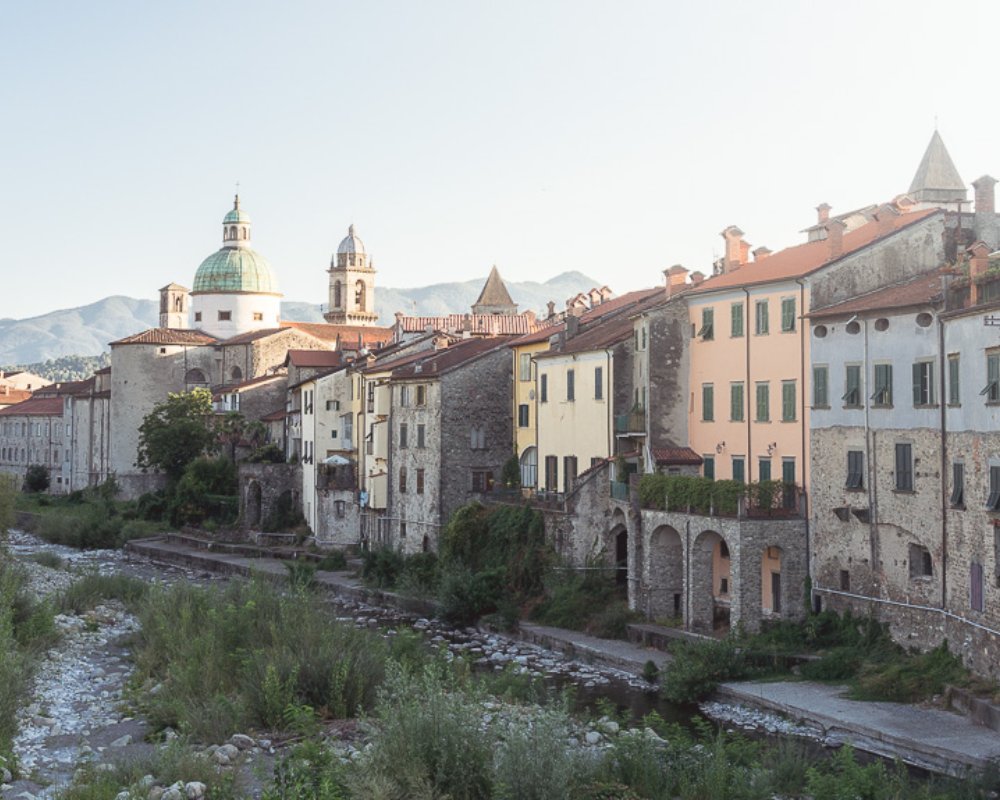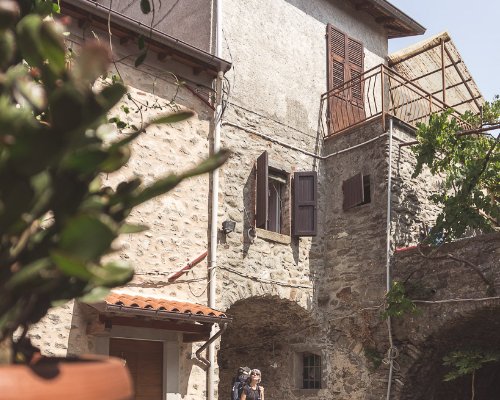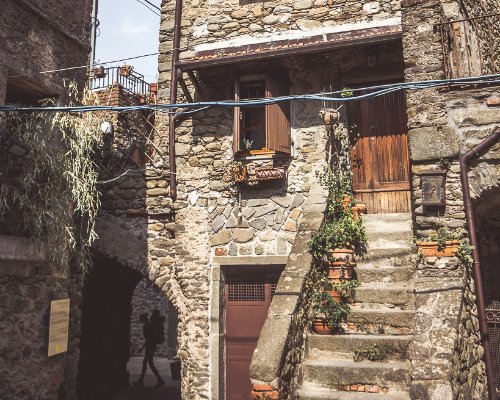From Pontremoli to Pietrasanta
Walking the Via Francigena in Tuscany is to experience a Tuscany not many others get to see. As a pilgrim trail, the Via Francigena is a quiet and contemplative route that runs through the whole region, so it offers the opportunity to explore the lesser-known parts of Tuscany, like the beautiful north.
We are walking travel bloggers over at What if we walked? and in 2017 hiked the whole Via Francigena from Canterbury in the UK to Rome, and we loved northern Tuscany particularly. It surprised and delighted us with its untouched medieval villages and tranquil mountain landscapes. So we’ve put together a suggested three day walking route, complete with pilgrim places to stay and eat, for you to experience one of our favourite hidden parts of the whole 2,000km route.
Begin in Pontremoli, the town right on the cusp of the border between Tuscany and Emilia-Romagna. The Apennines are behind you and Pontremoli itself sits along the banks of bubbling mountain river Verde. Or rather, sits in it: inside there are no less than six bridges criss-crossing the water in the labyrinth of medieval streets.
Join the Via Francigena heading south, and within 8km you’ll enter Ponticello, a quite incredible 1400-year-old village. Burrow into the underground streets and wind up the narrows stairways until you head on to Villafranca in Lunigiana.
Villafranca is a great place for a wander, with affordable pilgrim menus and places to stay if you plan to walk to Aulla the next day. But we suggest you hop on the train to Aulla and stay the night at the brilliant pilgrim hostel Parrocchia di San Caprasio. It’s also very close to Taverna Lunigianese (just across the river bridge) where you can sample a pilgrim menu, a generous and inexpensive three course set meal offered to walkers, including wine. Perfect after a good day’s hiking!
Alternatively, if you stay in Villafranca in Lunigiana you can take an extra day to walk to Aulla yourself (it’s 14km).
Begin in Pontremoli, the town right on the cusp of the border between Tuscany and Emilia-Romagna. The Apennines are behind you and Pontremoli itself sits along the banks of bubbling mountain river Verde. Or rather, sits in it: inside there are no less than six bridges criss-crossing the water in the labyrinth of medieval streets.
Join the Via Francigena heading south, and within 8km you’ll enter Ponticello, a quite incredible 1400-year-old village. Burrow into the underground streets and wind up the narrows stairways until you head on to Villafranca in Lunigiana.
Villafranca is a great place for a wander, with affordable pilgrim menus and places to stay if you plan to walk to Aulla the next day. But we suggest you hop on the train to Aulla and stay the night at the brilliant pilgrim hostel Parrocchia di San Caprasio. It’s also very close to Taverna Lunigianese (just across the river bridge) where you can sample a pilgrim menu, a generous and inexpensive three course set meal offered to walkers, including wine. Perfect after a good day’s hiking!
Alternatively, if you stay in Villafranca in Lunigiana you can take an extra day to walk to Aulla yourself (it’s 14km).
Today you walk from Aulla up into the beautifully jagged Apuan Alps. The Via Francigena also slips into Liguria, offering a glimpse into Tuscany’s coastal neighbour. The two pretty villages of Bibola and Vecchietto are first up on the route, high up in this picturesque and very quiet part of Tuscany with the mountains in full view.
Then the walk takes you over the border, zig-zagging through the hills with views of the Mediterranean Sea. End in the pretty Ligurian town of Sarzana. So leafy and green that plants seem to sprout from the very walls of the place, it is full of cafes to relax in before finishing the day.
Take the train from Sarzana to nearby Massa, back into Tuscany. So near to the famous Carrara marble quarries, everything but everything in Massa is made from marble – from the pavement kerbs to the marble monolith that is Massa Cathedral, called La Cattedrale dei Santi Pietro e Francesco. The mountains and the quarries make a dramatic backdrop to this marble city.
The impressive Ostello Palazzo Niza is a great place to stay in the centre of Massa, which is close to restaurants offering large pizzas perfect for a pilgrim.
Today you walk from Aulla up into the beautifully jagged Apuan Alps. The Via Francigena also slips into Liguria, offering a glimpse into Tuscany’s coastal neighbour. The two pretty villages of Bibola and Vecchietto are first up on the route, high up in this picturesque and very quiet part of Tuscany with the mountains in full view.
Then the walk takes you over the border, zig-zagging through the hills with views of the Mediterranean Sea. End in the pretty Ligurian town of Sarzana. So leafy and green that plants seem to sprout from the very walls of the place, it is full of cafes to relax in before finishing the day.
Take the train from Sarzana to nearby Massa, back into Tuscany. So near to the famous Carrara marble quarries, everything but everything in Massa is made from marble – from the pavement kerbs to the marble monolith that is Massa Cathedral, called La Cattedrale dei Santi Pietro e Francesco. The mountains and the quarries make a dramatic backdrop to this marble city.
The impressive Ostello Palazzo Niza is a great place to stay in the centre of Massa, which is close to restaurants offering large pizzas perfect for a pilgrim.
After exploring Massa hike out of the city on the Via Francigena and quickly come to Castello Malaspina, the imposing hilltop castle. The steep climb will reward you with stunning views of Massa and the sparkling Mediterranean Sea.
This three-day walk ends in the totally underappreciated Pietrasanta. If you like Lucca, you’ll really like Pietrasanta: very chic with a long artistic heritage, it’s the home of many galleries and sculpting workshops. It also has a lovely piazza in front of the beautiful Duomo of St Martino, fronted (of course) by creamy white marble. Look out for the temporary sculpture exhibitions housed in the Piazza.
It’s the perfect place to toast your three-day exploration of Northern Tuscany on the Via Francigena.
There’s only one place to try and stay as a pilgrim in Pietrasanta and that’s at Casa Diocesana La Rocca, run by the nuns and somewhere to share a meal with other pilgrims.
After exploring Massa hike out of the city on the Via Francigena and quickly come to Castello Malaspina, the imposing hilltop castle. The steep climb will reward you with stunning views of Massa and the sparkling Mediterranean Sea.
This three-day walk ends in the totally underappreciated Pietrasanta. If you like Lucca, you’ll really like Pietrasanta: very chic with a long artistic heritage, it’s the home of many galleries and sculpting workshops. It also has a lovely piazza in front of the beautiful Duomo of St Martino, fronted (of course) by creamy white marble. Look out for the temporary sculpture exhibitions housed in the Piazza.
It’s the perfect place to toast your three-day exploration of Northern Tuscany on the Via Francigena.
There’s only one place to try and stay as a pilgrim in Pietrasanta and that’s at Casa Diocesana La Rocca, run by the nuns and somewhere to share a meal with other pilgrims.


